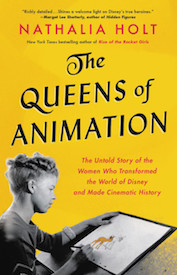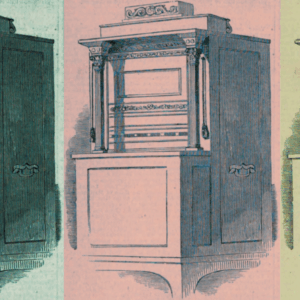
Inside the Early Struggles of the Women Who Built Disney
Nathalia Holt on What It Took to Break Into Animation in the 1930s
Under her desk was a pig. Grace stared unbelievingly at the real live farm animal rooting its dusty pink snout in a heap of crumpled paper, the garbage can beside it overturned. She glanced around the room looking for some explanation for the animal’s appearance, but nothing else in the office was amiss. The men of the story department sat at their desks, seemingly oblivious to their barnyard intruder. Grace put her hands on her hips and called out to the room, “Hello? What’s going on here? There’s a pig at my desk!”
The men turned their heads toward her, their faces bland and expressionless at first, but then the quiet room exploded. All around her, the story men and animators erupted with laughter, clapping madly, as if they were watching the final act of a star-studded performance. Grace looked around, astounded, before smiling and giggling nervously, trying to pretend that she didn’t mind being the object of persistent jokes. This must be what Walt meant when he said that I couldn’t be too sensitive, she thought as she stared into the pig’s brown eyes, her smile now frozen in place.
Grace was struggling to fit in at the studios at 2719 Hyperion Avenue in a neighborhood known as Silver Lake, just east of Hollywood. From the outside, the Walt Disney Studios looked homey and unintimidating. There was a small cluster of white stucco buildings with red-clay roof tiles surrounded by a whitewashed brick wall. At the top of the main building hung a cheerful hand-painted sign: WALT DISNEY STUDIOS, MICKEY MOUSE AND SILLY SYMPHONY SOUND CARTOONS. A cartoon Mickey Mouse stood at its peak, his hand raised in welcome. Despite the fame of Mickey Mouse, the “mouse studio” confused local residents, and quite a few stray cats were tossed over the fence by well-meaning neighbors. The kittens found their new home far more comfortable than Grace did at first. They spent their days napping in the grass and were doted on by the studio staff; even Walt would stoop to stroke them.
The feline population wasn’t the only aspect of the studio that was growing. In 1936, the company took out an ad in Popular Mechanics that read “Walt Disney Wants Artists” in bold type; this was followed by “Walt Disney, creator of Mickey Mouse and Silly Symphonies, offers exceptional opportunities to trained male artists. Write for particulars, giving age and occupation.”
The advertisement itself was not new—the company had put out similar ones over the past few years—but its placement in the prominent magazine brought in a flood of young men, all of them starting work at the same time as Grace. Establishing a career in animation was an arduous slog. The atmosphere was jovial on the surface, but the competition was cutthroat. Animators were hired at a fast pace. They were employed as apprentices and stuffed in a rear building known as the annex, and the new hires knew that the majority of them would last mere months. If they wanted to stay, they had to prove themselves, and quickly. While the ability to steadily churn out drawings was one requirement of the job, artistry in creating the characters was the true necessity. Whether an animator could breathe life into his drawings determined if he would ultimately last at the studio.
With this pressure, the atmosphere in the annex turned aggressive, even among those with permanent jobs. Practical jokes became a way to release tension, and the young staff was relentless. The long hours spent together formed a rushed intimacy among them all even as they tortured one another at story meetings. While Walt often held smaller meetings with his writers, large story meetings also took place that were attended by members of both the animation and story departments.
As she searched for a seat, the men began calling and whistling, trying to attract her notice.
Grace’s first story meeting was as painful as Bianca had feared it would be. As Grace approached the soundstage building where the regular meetings were held, a security guard blocked her path.
“Sorry, ma’am, this is a story meeting. Restricted entry.”
“I’m a writer here and I’m supposed to attend these meetings,” Grace explained, puzzled.
“Women aren’t admitted to the story meetings. It’s men only,” the guard said gruffly, then turned his head from her.
“No, no, you’re mistaken. I’m a new hire, and I should be in there.” She gestured to the door. “And anyway there’s another woman in the story department!”
“Nope, all the women work in Ink and Paint.” The guard pointed to the building across the unkempt, weed-filled lot. “No women in here. I’m afraid I can’t let you in.”
Grace could feel the anger bubbling up as she fought to keep her voice calm. “I’m going in now. The meeting is starting and I need to be a part of it.” She stomped by the security guard, who was too stunned by her boldness to restrain her.
Her cheeks flushed from the encounter, she made her way through the double doors and down the aisle. She was early, despite her delayed entry, but inside, 50 men already filled the room. As she searched for a seat, the men began calling and whistling, trying to attract her notice as if she were a shapely woman passing a particularly crass crowd of high-school boys. The whistles rattled her, heightening her insecurities and forming an invisible barrier of exclusion somewhat stronger than the one imposed by the security guard outside. Ignoring their pursed lips and open mouths, she spotted a seat in the middle of an empty row and sat, her muscles tense even as the room continued to fill with more writers and animators. She waited for another woman to come in so she could point out how mistaken the security guard had been. Yet none appeared; all the rows around her became crammed with men, 75 staff members ultimately packing in, until every seat in the auditorium appeared to be filled except for two—the ones on either side of Grace.
While Grace sank into the embarrassment of isolation, Bianca reveled in her solitude. She skipped as many story meetings as she could, her attendance becoming infrequent not entirely due to her pride or her fear but simply because she felt her time was better spent elsewhere.
She sometimes retreated to odd places. One day Bianca got a call she had long been anticipating: A new baby was coming into the world. Walt had arranged for the staff at the San Diego Zoo to call Bianca when a pregnant deer went into labor, a process that typically lasted twelve hours or more, and now the time had come. Bianca dropped what she was doing and drove the two and a half hours south. She arrived at the zoo to see a white-tailed deer lying in the grass with a small pair of hooves beginning to emerge from her womb. She immediately got out her sketch pad and pencils and began drawing the doe, tracing the long curve of the animal’s neck. Her grip on her pencils faltered, however, when the fawn made its first appearance in the world. Bianca watched, mesmerized, as the doe stood and licked her newborn, its sticky brown coat dappled with white spots as it lay trembling in a heap.
Within ten minutes, the baby was already testing out its new legs, standing up and wobbling uncontrollably before falling down again. Bianca laughed as she watched the animal’s persistence. She wasn’t expecting to find comedy here, yet it was just the sort she reveled in, the tenderness of the fawn’s birth mingling with the silly spectacle of its first steps. She recognized that the sweetness of the situation enhanced its humor. She drew the wobbly legs of the newborn over and over, making copious notes as she observed the first meeting between mother and child. She could feel in her gut that here, in this moment, was a critical scene in their next project, and she wanted to be sure to capture it completely.
Even as the studio’s staff labored over Snow White, having no idea whether their first foray into feature films would be a huge success or merely a long cartoon few would bother to sit through, Walt was looking to the future. Bianca was at the forefront of that endeavor. The studio was interested in adapting Felix Salten’s novel Bambi: A Life in the Woods, first published in serialized form in a Viennese newspaper in 1923. While Walt was working on obtaining the rights, which had already been optioned by another filmmaker, Bianca began to explore the possibilities of the story. There was beauty in the book, a description of the woods such as she had never read before, and it made her feel incomparably tranquil— that is, until the humans showed up.
The human ability to destroy what is beautiful and precious was growing in 1936. As Bianca was finding artistic inspiration in Salten’s novel, other copies of it were being thrown into bonfires in Nazi-controlled Germany. The book was banned not only because of the author’s Jewish heritage but also for its metaphors about anti-Semitism. At one point in the story, the deer ponder peaceful integration with the human world, asking each other, “Will they ever stop persecuting us?” Many readers understood the book as an allegory about the Jewish experience of oppression in Europe. The experience of marginalization is repeated throughout the book; even the butterflies of Salten’s novel experience a diaspora not unlike that of Jewish communities. Bambi describes the winged creatures as “beautiful losers [who are] always searching farther and farther because all the good places have already been taken.”
The book’s message of peace made the project dear to Bianca. She had come to the studio seeking purpose in her life, and in many ways the cartoon shorts that were the primary output of Walt Disney Studios were failing to provide it. Sometimes she felt she had little to add to the crass jokes, crude stereotypes, and predictable gags. Her story ideas for the shorts, which she poured hours into developing, were often passed over. Despite the stinging unhappiness of her work life and her feelings of inadequacy, however, her career at the studios was taking off. Her Elmer Elephant Silly Symphony short was proving exceptionally popular in theaters. Walt showed Bianca a report from Kay Kamen, the studio’s merchandising executive, saying that the character had “taken hold” and that it would be “a good idea if we could have another Elmer Elephant picture.”
The elephant who tried to fit in, endured rejection, then found strength in his perceived physical flaws was a surprising success. Elmer Elephant was different from the other Silly Symphony shorts. Bianca had infused the story with anguish and longing in a way that had not been attempted by Walt Disney Studios before. The slapstick comedy, though still present, was diminished, and the story department found a lesson for their own work: that sadness transforms comedy, tingeing its edges with emotion and thus delivering fewer laughs but more real humor. Despite the importance of this message, it wasn’t at all clear whether Walt would make more shorts like Bianca’s.
After an awkward first few months for Grace, her isolation at the studio was ebbing. She had friends, her confidence was growing, and she found herself able to make significant contributions at story meetings for both the shorts they were developing and the one project that absorbed more energy than any other: Snow White.
“I’m modeling your face for one of our characters in Snow White.” “Which one?” “The evil queen.”
Perhaps the success of Grace and Bianca encouraged Walt to hire more women. In the summer of 1936, he brought a woman named Dorothy Ann Blank into the story department. Right away people realized she was an unusual hire, unable to sketch or draw, a talent that most of the writers used in shaping their plots. What she lacked in ability in the visual arts, however, she made up for in her adroit prose. Dorothy was a journalist who had worked for College Humor and Redbook before being hired by a publicist named Hal Horne. Horne published the Mickey Mouse Magazine, a children’s periodical that had so little success that by 1936, Walt and his brother Roy, feeling pity for the man, let him produce it on a royalty-free basis.
Horne’s offices on Fifth Avenue in New York City looked like a hoarder’s paradise. Several rooms were filled with boxes of three-by-five-inch index cards; they lined the walls and occupied every inch of available space. These cards were his “gag file,” a collection of six million jokes that Horne sometimes rented to comedians or comic-strip artists. The cards were the comedic contents of his skull, although they were not particularly amusing. Along with stale, uninspired one-liners, the files were crammed with jokes organized into categories such as “Dumb Dames” and “Laziness.” Perhaps to compensate Horne for his failed enterprise and the loss of much of his personal fortune, over fifty thousand dollars, Walt agreed to purchase the gag file for a substantial sum: twenty thousand dollars. Walt had become accustomed to paying for laughs. In the story department, he regularly handed out five dollars per gag in the hopes of encouraging better comedy than his writers’ regular salaries could command.
The collection of white cards made its way from New York to Los Angeles, but it did not travel alone. Accompanying the gag file to its new home was Dorothy Ann Blank, who, although Walt didn’t realize it yet, would become far more valuable to the studio than the vast joke collection. The index cards were soon organized by Dorothy and one of the studio’s librarians, Lillian Grainger, in a card-catalog format, neatly arranged in pullout drawers and housed in an area that became known as “the room of a million jokes.”
Horne’s comedy was wooden and artificial, so the story department promptly dismissed the jokes on the index cards, but Dorothy could not be so easily ignored. Women were no longer a complete oddity in the story department, and it was quite clear that Dorothy could hold her own with the writers. She exuded confidence with the effortlessness of a person who knows her worth, and she dived into Snow White without hesitation. By the end of 1936 she was exerting significant influence on the scene cards for Snow White and the Seven Dwarfs, rewriting the summaries in her own succinct style. Most important, she was writing story treatments, the outlines that shape the script of the entire film.
Dorothy realized that Walt was obsessed with every aspect of Snow White. At story meetings he would delve into each scene in detail. Yet he was concealing an issue that threatened all their livelihoods: The studio was completely out of money. Walt and Roy had spent a million dollars on it so far, a substantial sum for a film at the time, and they needed more. Around town, some called the movie “Disney’s Folly,” believing the big-budget cartoon was destined for failure. Walt hoped that making a feature film would end the financial woes of the studio, and he and Roy quietly met with their banker and desperately tried to convince the man that they were a worthy investment.
Unaware of the troubles of her employer, Dorothy became consumed with whittling away at the scenes, keeping only what was essential. At Walt’s direction, she was paring down the script so that not a word was wasted. Dorothy also wrote the title cards, the filmed, printed text that accompanies the scenes. Near the end of the film, as the seasons pass while the seven dwarfs wait for Snow White to awaken from her slumber, Dorothy wrote, “So beautiful, even in death, that the dwarfs could not find it in their hearts to bury her.” And as snow falls: “They fashioned a coffin of glass and gold, and kept eternal vigil by her side.” Her sentences advanced the story in as few words as possible. It was Walt himself who rewrote the last title card of the film, editing Dorothy’s words to read simply, “The Prince, who had searched far and wide, heard of the maiden who slept in the glass coffin.”
The fact that Dorothy could not draw made her unusual in the story department. While most of the artists there sat at their desks sketching with paper and pencil, Dorothy was frequently at her typewriter. The clanging of the carriage return, loud as it was, could barely be heard above the persistent din of the department, which was frequently filled with the animated chatter of the artists as they sketched. Many of the writers couldn’t type; Grace could only peck at the machine with two fingers. Dorothy’s typewriter did give her the advantage of space, however. Most writers did not have the luxury of an office and so worked crammed together, their elbows occasionally bumping as they drew mouse ears or princess dresses. Dorothy and her typewriter had a prime corner location, and from this vantage point she could survey the room, her eyes meandering across the faces of her colleagues as she searched the air for ideas.
Dorothy noticed that one of the story men was often looking back at her. Joe Grant had been working for Walt for three years. Originally hired as a caricaturist, he had made his way into the story department not so much because of his gift for words but because of his art, from which emerged complex plots and refined dialogue. Yet it now seemed that Joe had become obsessed with Dorothy’s image. She frequently saw him sketching her from a perch nearby, periodically staring at her before returning to the page.
Most new hires would have shied from his gaze, afraid to disturb the dynamics of the story department and possibly become the target of pranks, but Dorothy was rarely afraid of anyone. “What are you doing?” she asked him bluntly when she noticed him watching her.
“You are an inspiration,” Joe replied with a smile, but Dorothy was not so easily mollified.
“But why are you sketching me?” she demanded.
“I’m modeling your face for one of our characters in Snow White.” “Which one?”
“The evil queen,” Joe replied curtly.
Dorothy burst out laughing—his answer had been so unexpected—and soon Joe was laughing too. At last Dorothy said, “At least I’m not the old hag!”
Thanks to Joe, it was not merely Dorothy’s words that would find a permanent home in the film but her face as well: her arched eyebrows, her almond-shaped eyes, and her long, straight nose were all reflected in the face of the beautiful but vain and wicked stepmother.
*
In their own department, the animators frequently propped up mirrors on their desks so that they could capture their facial expressions and infuse realism into their animation. They would take their rough sketches, hand them over to be photographed, then bring the film to a Moviola, an early device used by film editors to view individual shots and check whether the movements they had created were true to life. Meanwhile, the story department went over the plot for Snow White again and again, mercilessly cutting scenes in order to bring the story into crisp focus and working with the composers to weave the musical score into the story. Yet no matter what they did, the art the animators created was flat. There was no dimension, no depth.
In the mid-1930s, most animation was produced by hand-drawing the characters on cels and then placing the cels, one panel at a time, on top of a painted background. The animation camera would take a picture of the combined artwork from above, each shot but one frame of the movie. With every frame, the background shifted ever so slightly backward, so that when viewing the sequence on film, the observer got the impression of forward movement. Compared to the walking, talking characters, however, the background offered little variety. It was typically painted onto a long roll of paper that was dragged behind the characters. There was no sense of perspective and little detail. If the camera zoomed in, the images would become severely distorted, making the scene even less realistic. It was an undeniable problem for the studio.
The solution lay in a trick taken from live theater: adapt the set to let the characters move through the scenery, not merely on top of it. Just as cutouts and objects are placed at different points up- and downstage from the actors, the animators needed to create depth between the elements of their backgrounds. In early 1937, this became possible thanks to a relatively new invention in the art of animation: the multiplane camera. The camera stood just over eleven feet tall and incorporated horizontal beams over long metal cradles designed to hold massive glass frames.
Instead of photographing a flat two-dimensional background, the multiplane camera separated each element of the scene: the foreground, the middle ground, and the background. Each part of the backdrop was painted on a long pane of glass and then placed in a cradle that moved independently of the others, up and down and from side to side. At the very top, positioned to look down through the panes of glass, were the eyes of the structure: a Victor 16 mm movie camera. Some of the pieces of glass were hand-painted in oils; the immovable glass closest to the floor was often tinted the color of the sky. Those panes closest to the camera were kept clear so that cels with the artists’ animation could be gently laid on top. With the camera shooting from above, the contraption gave depth and realism to the scene, transforming the flat panes of painted glass and plastic into a three-dimensional world.
Bill Garity and a team of engineers were testing the limits of this new technology in the studio’s motion picture laboratory, improving on the design as he tweaked the camera’s motion and timing. As innovative as the equipment was, though, it was hardly the first of its kind. Charlotte “Lotte” Reiniger, a German filmmaker, is widely recognized for developing the first multiplane camera for her 1926 animated feature The Adventures of Prince Achmed. Reiniger’s features were filmed in silhouette. To create her characters, she would deftly cut out of black cardboard the shapes of people, flowers, animals, and fairies. She placed the silhouettes, exquisite in their detail, onto vertical planes of glass hung in front of the movie camera. The resulting scenes were so rich that her fairy-tale films drew viewers deep into misty forests, took them on a flight through the clouds on a magical horse, and plunged them beneath the surface of a meadow pond.
Reiniger’s innovations were finding fresh application in California. Even before Walt began testing the multiplane camera, his competitor and sometime friend Ub Iwerks was building his own. Iwerks and Walt had met in Kansas City, Missouri, in 1919, where Ub animated Mickey Mouse and Silly Symphony shorts and played a critical role in shaping Walt’s characters. By 1930, he’d left Walt to start his own studio, and by 1933, he had built a multiplane camera from an old Chevrolet chassis. Its structure was horizontal, unlike Reiniger’s vertical mechanism, but otherwise operated similarly. Yet despite his prowess at bringing depth into his cartoon shorts, Iwerks couldn’t match the success of Mickey Mouse, and his studio closed its doors in 1936.
Walt saw the potential of the multiplane camera to bring realism to Snow White. But before Walt Disney Studios could use the system for a feature film, they had to assess the technique. Their testing ground was an animated short titled The Old Mill. Released in 1937, the cartoon had neither a defined plot nor any central characters, but it was a veritable workshop for the many improvements Walt wanted to bring to Snow White. In addition to their first use of the multiplane camera, the team toyed with complex lighting and water effects, realistic portrayal of animals, and heightened mood and suspense. The outcome was stunning. The cartoon would go on to win two Academy Awards, one for best short and one for technical achievement. The company filed a patent for the multiplane technology and set to work filming Snow White with the nimble new machinery.
__________________________________

Excerpted from the book The Queens of Animation by Nathalia Holt. Copyright © 2019 by Nathalia Holt. Reprinted with permission of Little, Brown and Company. All rights reserved.
Nathalia Holt
Nathalia Holt, Ph.D. is the New York Times bestselling author of Rise of the Rocket Girls: The Women Who Propelled Us, from Missiles to the Moon to Mars and Cured: The People who Defeated HIV. Her writing has appeared in numerous publications including The New York Times, the Los Angeles Times, The Atlantic, Slate, Popular Science, and Time. She is a former Fellow at the Ragon Institute of Massachusetts General Hospital, MIT, and Harvard University. She lives with her husband and their two daughters in Pacific Grove, California.












